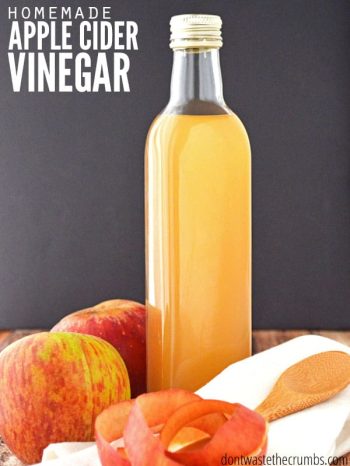How to Make Apple Cider Vinegar
Make apple cider vinegar at home, using apple scraps or whole apples, with this easy tutorial. Save money, reduce food waste, and make ACV in under 5 minutes!
- Prep Time: 6 weeks
- Total Time: 6 weeks
- Yield: 32 oz 1x
- Category: Kitchen Hacks/Tutorials
- Method: Fermentation
- Cuisine: American
Ingredients
Scale
- Apple peels, cores and any browning/discolored flesh from pesticide-free apples (approx 6 large apples)
- One quart jar like these (or whatever you have on hand)
- One canning lid ring OR a rubber band
- Coffee filter OR paper towel
- 2–2 ½ Tbsp granulated sugar (I like Turbinado raw sugar)
- 2–2 ½ cups water, boiled and allowed to cool
Instructions
- Cover the bottom of your jar with apple scraps, filling no more than ¾ full. The apples need room to expand and stay submerged.
- Add 2 Tbsp of granulated sugar and 2 cups of filtered water to the jar. The apples should be completely submerged. Mold can grow on any portions of apples that are not covered and ruin your batch of vinegar. If your scraps float to the top of the jar add a smaller jar on top to keep them submerged.
- Stir the apples, sugar, and water and cover with a coffee filter. Secure with a canning band, or a rubber band.
- Allow apples to sit in a warm, dark place for 2 weeks. Above the refrigerator or on the top shelf of a cupboard are great places. Just don’t forget you put it there!
- After 2 weeks, you might notice some fizz or bubbles. That’s good news! Strain out the apple pieces and compost. Cover the apple cider vinegar again with a coffee filter and canning band. Allow continuing to sit at room temperature for another 2-4 weeks.
- The vinegar may become cloudy or a SCOBY could form on the top, both of which are normal. Taste test the vinegar once a week until it’s to your liking. You can stop the fermentation process by replacing the coffee filter with a canning lid and storing it in the refrigerator.
Notes
- Avoid chlorinated water. Most cities use chlorine to combat bacteria in water, but this small amount of chlorine can react with fermentation and vinegar. Be sure to use filtered water or boiled water that has cooled.
- Don’t use metal containers. Metal containers will also react with fermentation and vinegar, so make sure you’re using only glass jars. (Silicone, wood, and plastic utensils are fine to use.)Speed up the process: You can use apple cider vinegar as a “starter” and add 1 ½ Tbsp raw apple cider vinegar for every 2 cups of water to help kick start and speed up the fermentation process. If you do this, strain the apples after just one week and taste each week after that.
- Make sure your jar is covered well with a coffee filter or paper towel so fruit flies can’t get inside!
Nutrition
- Calories: 23

